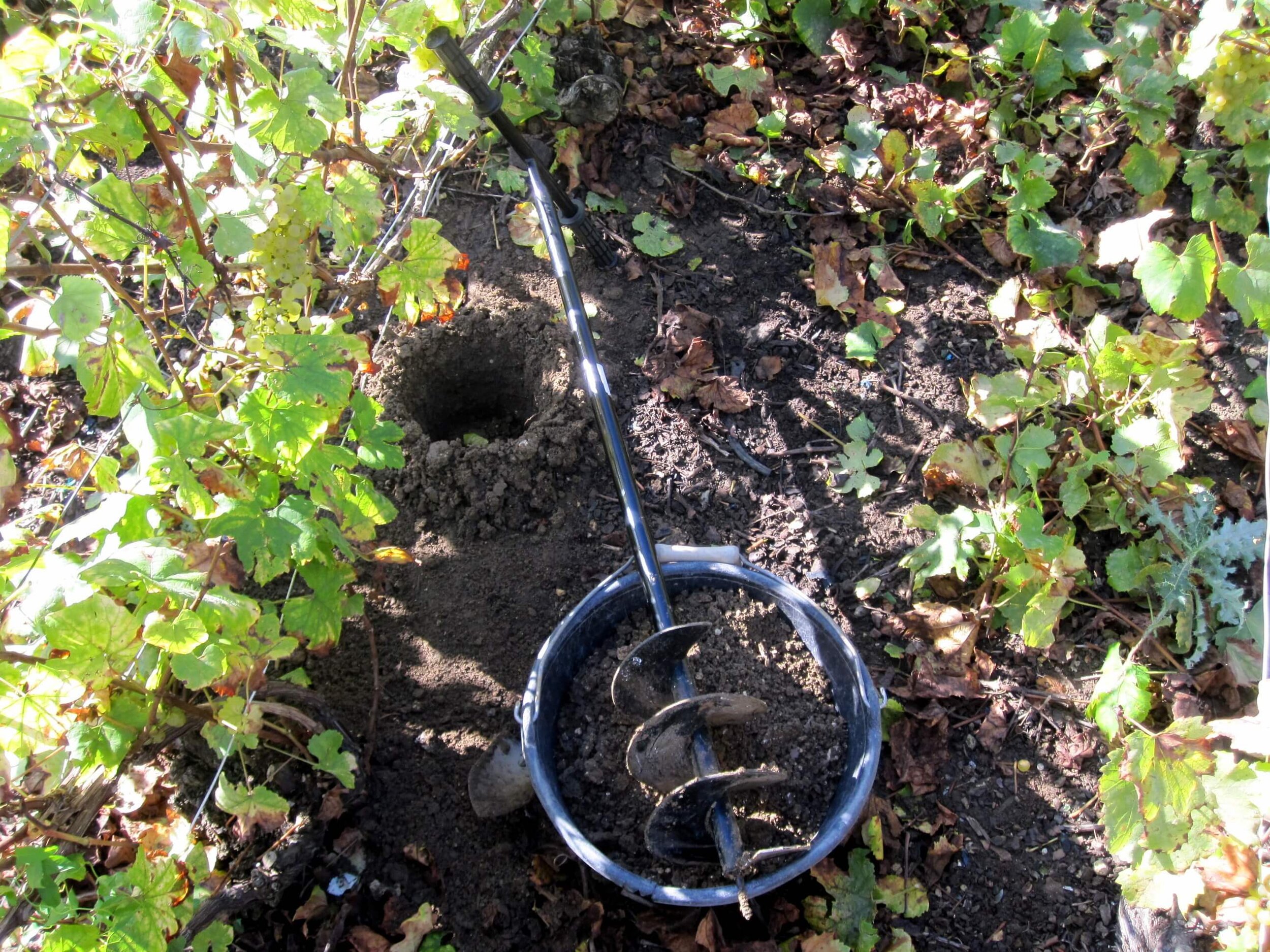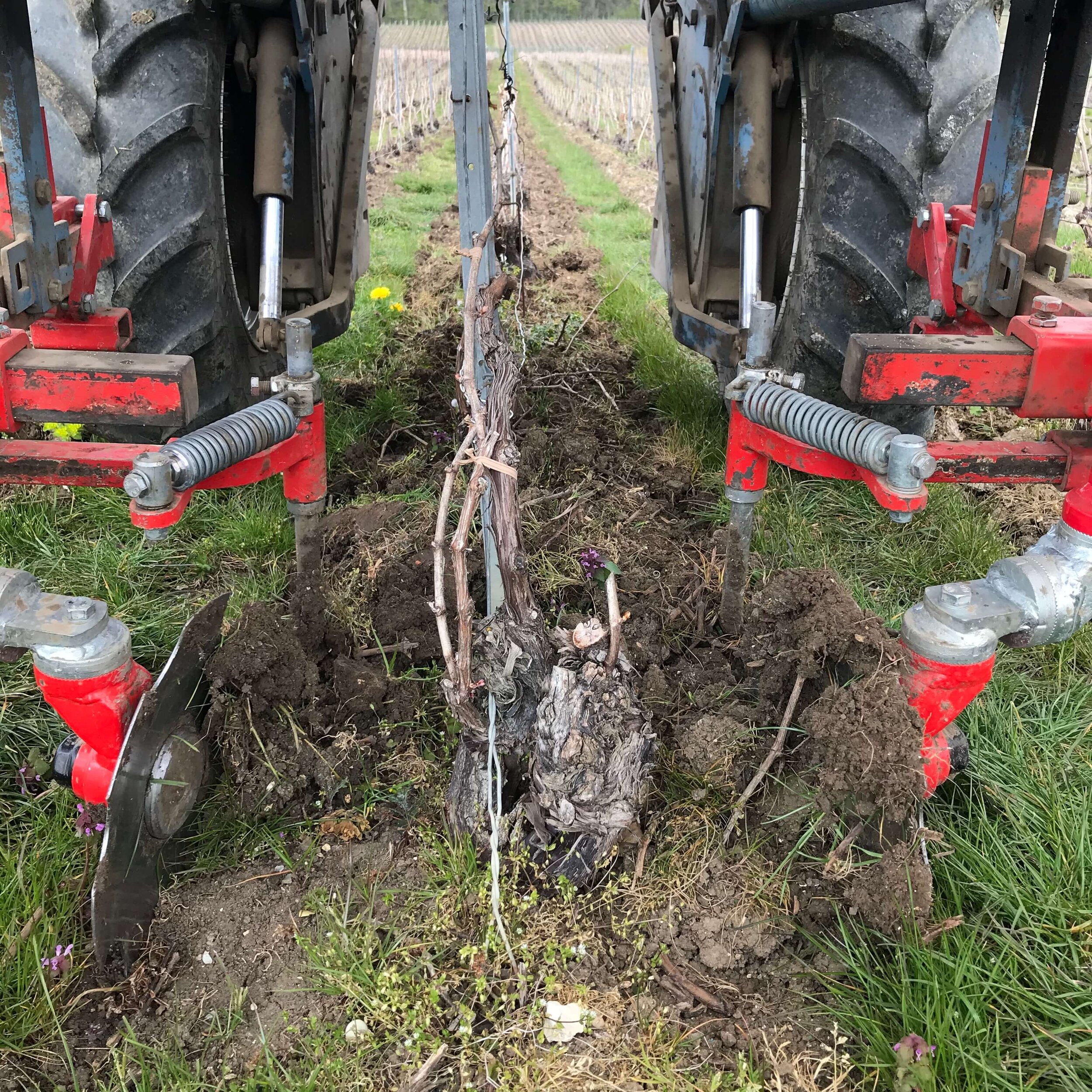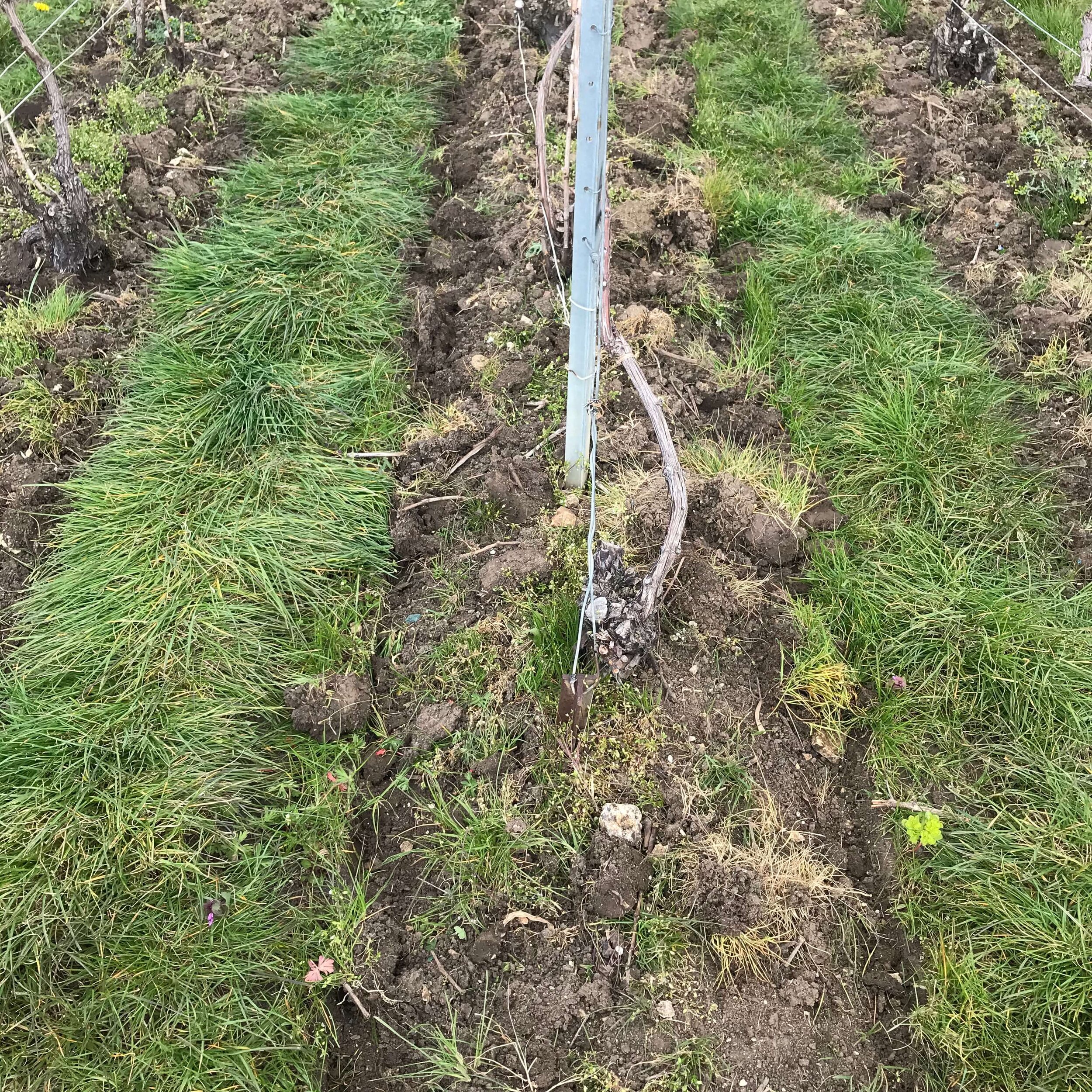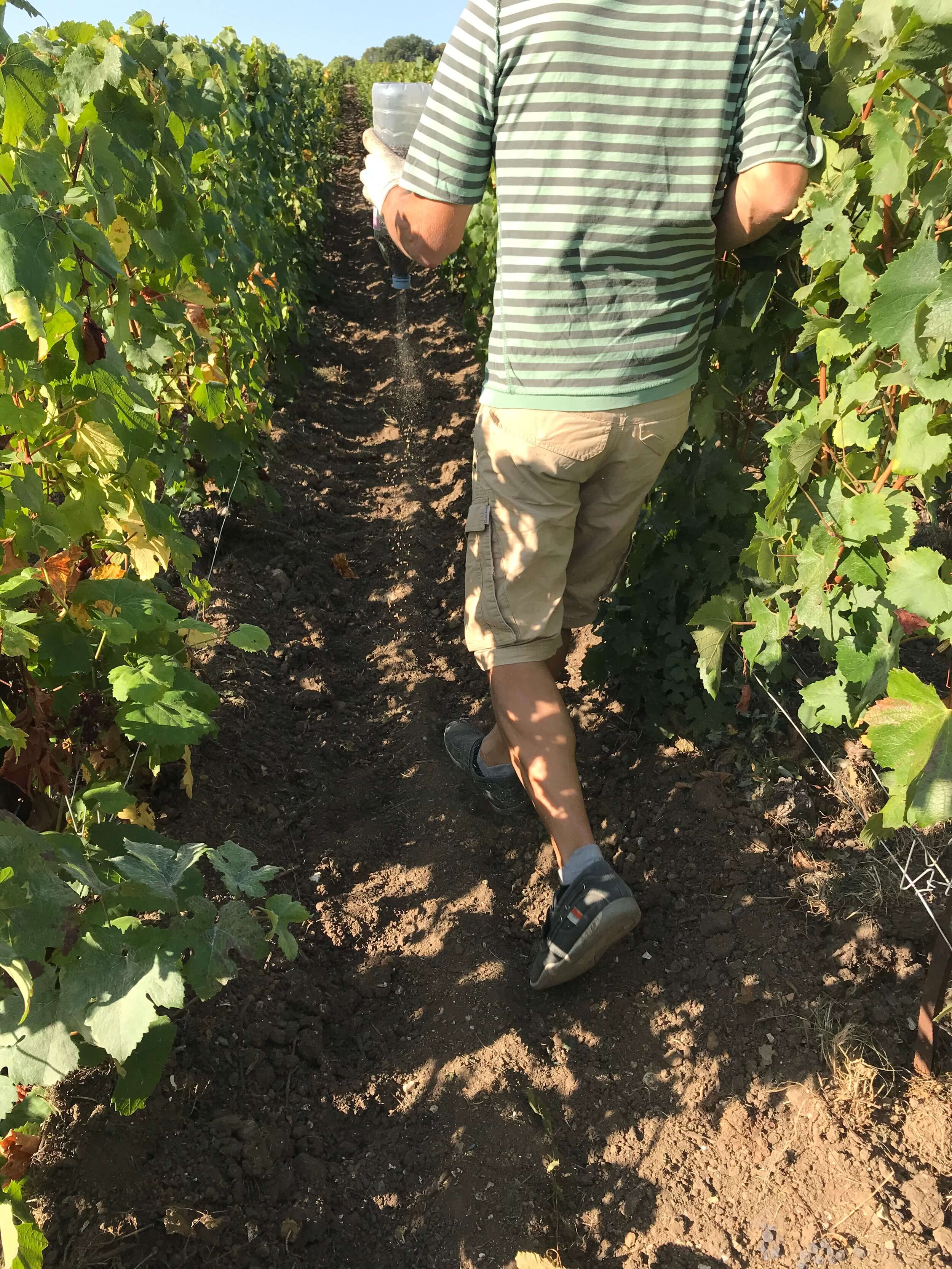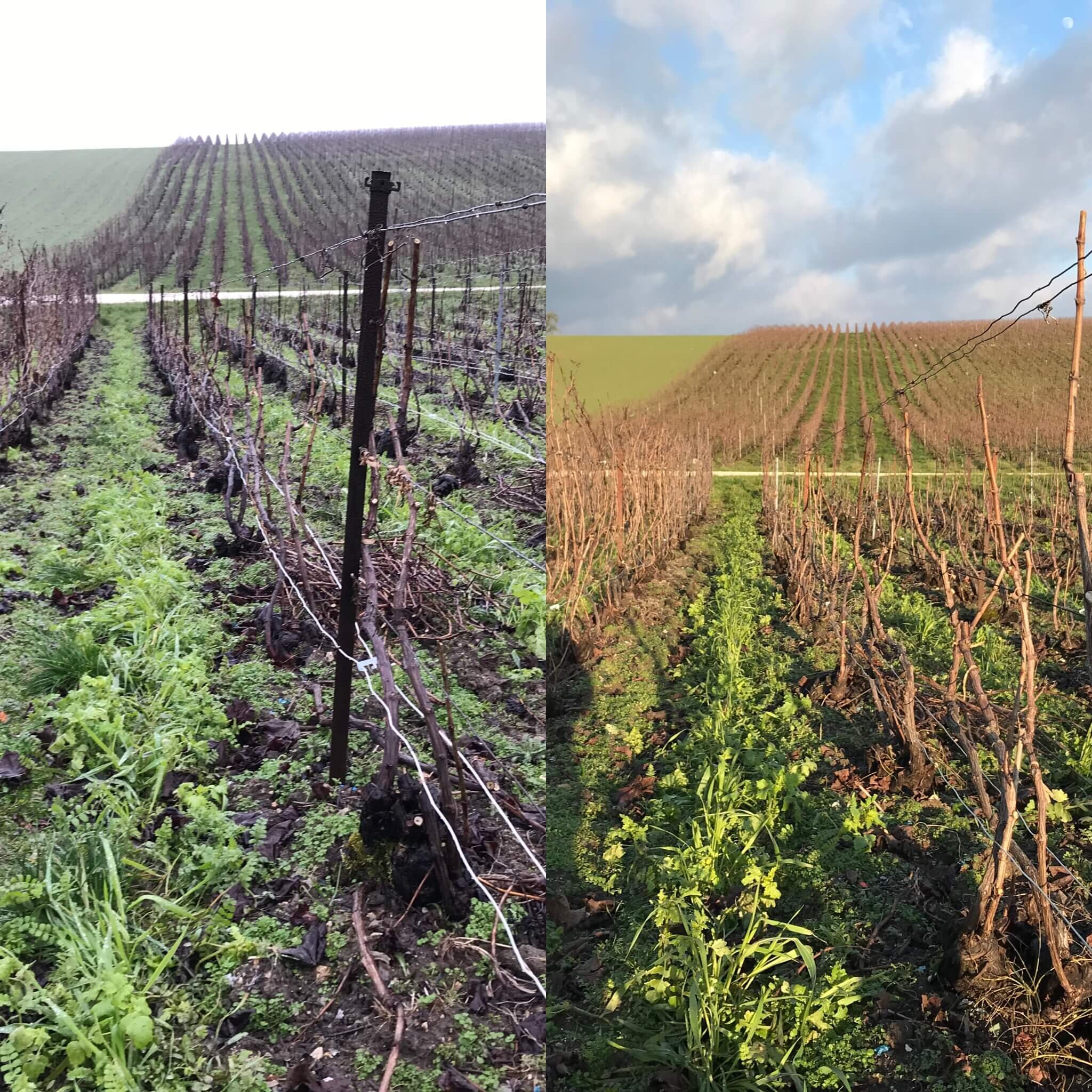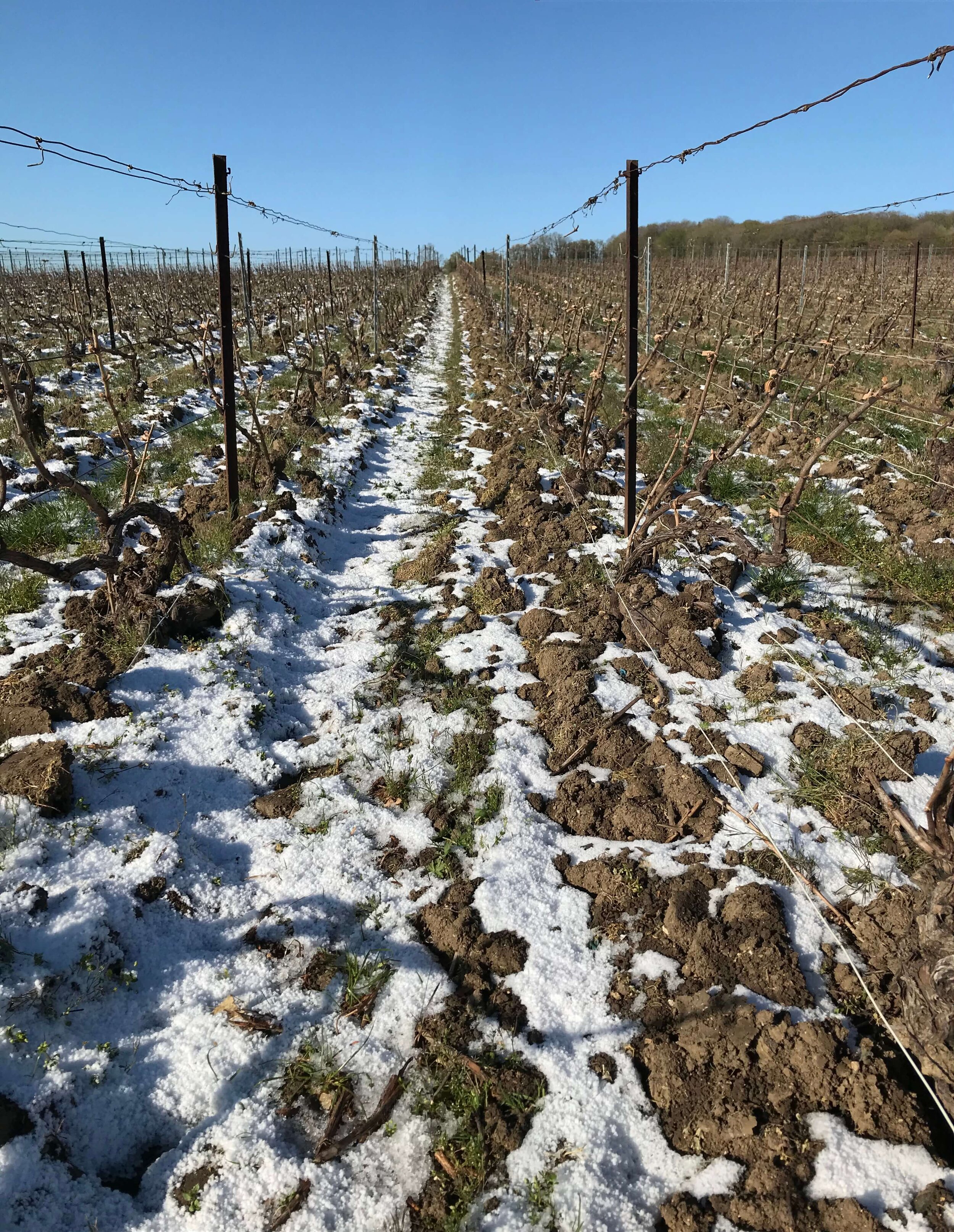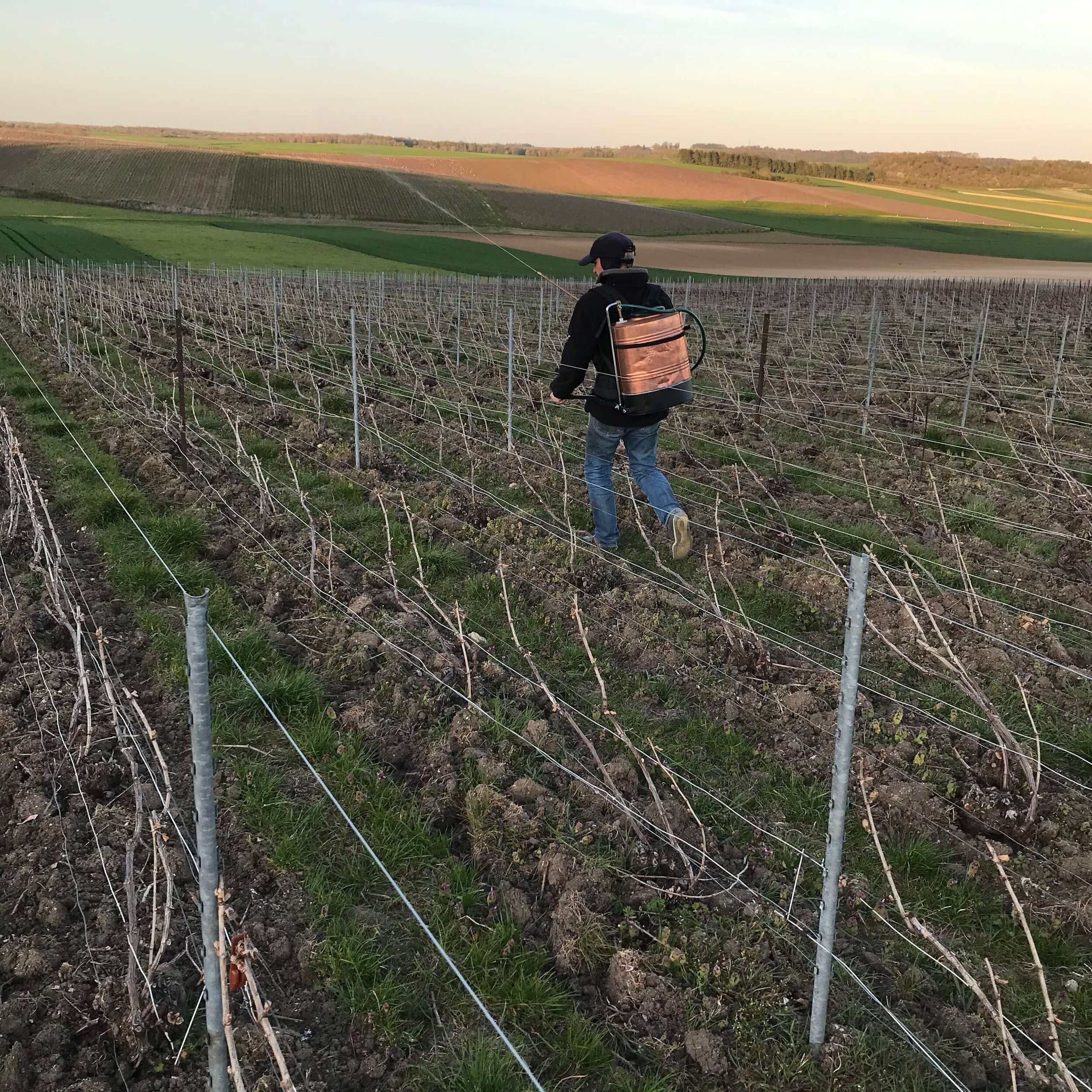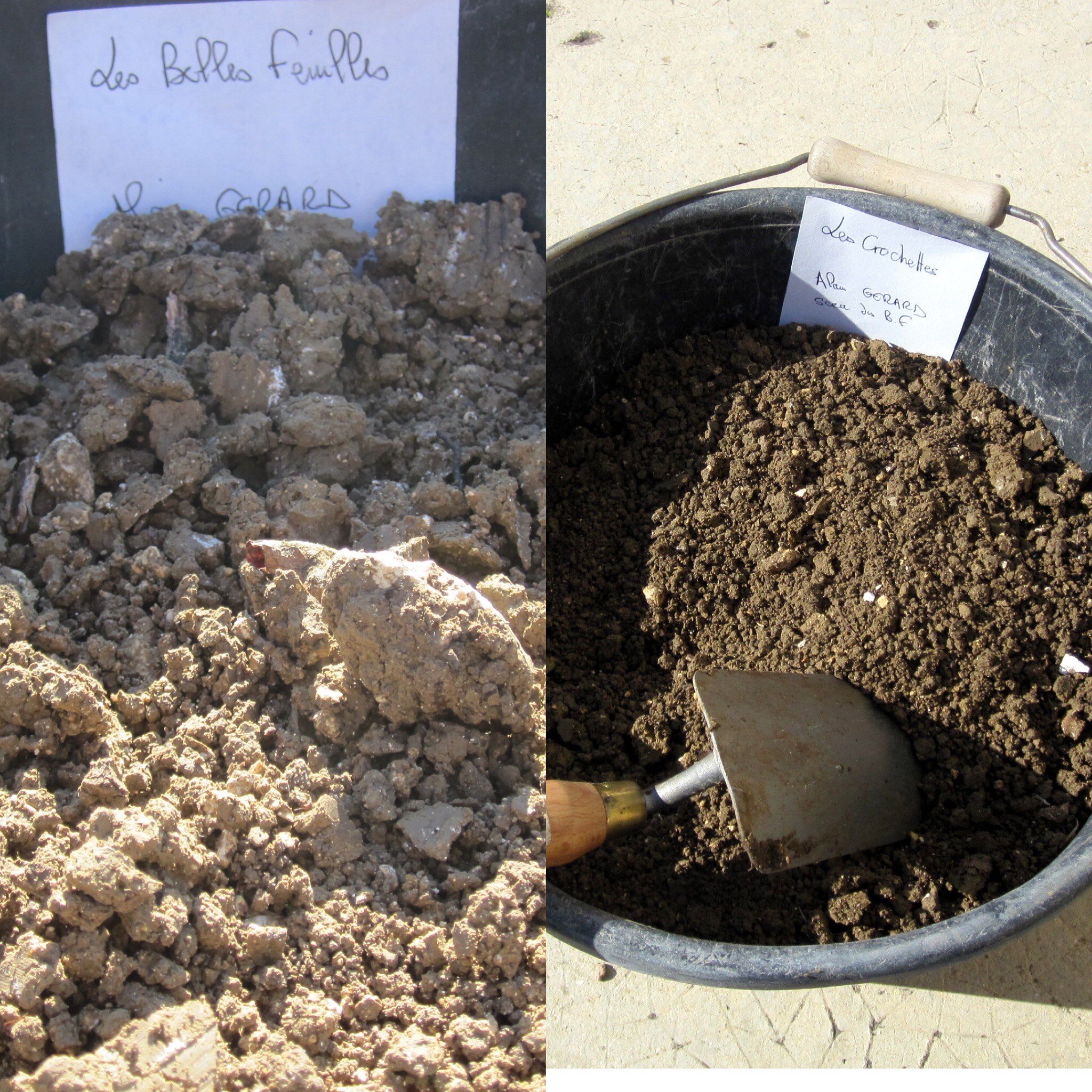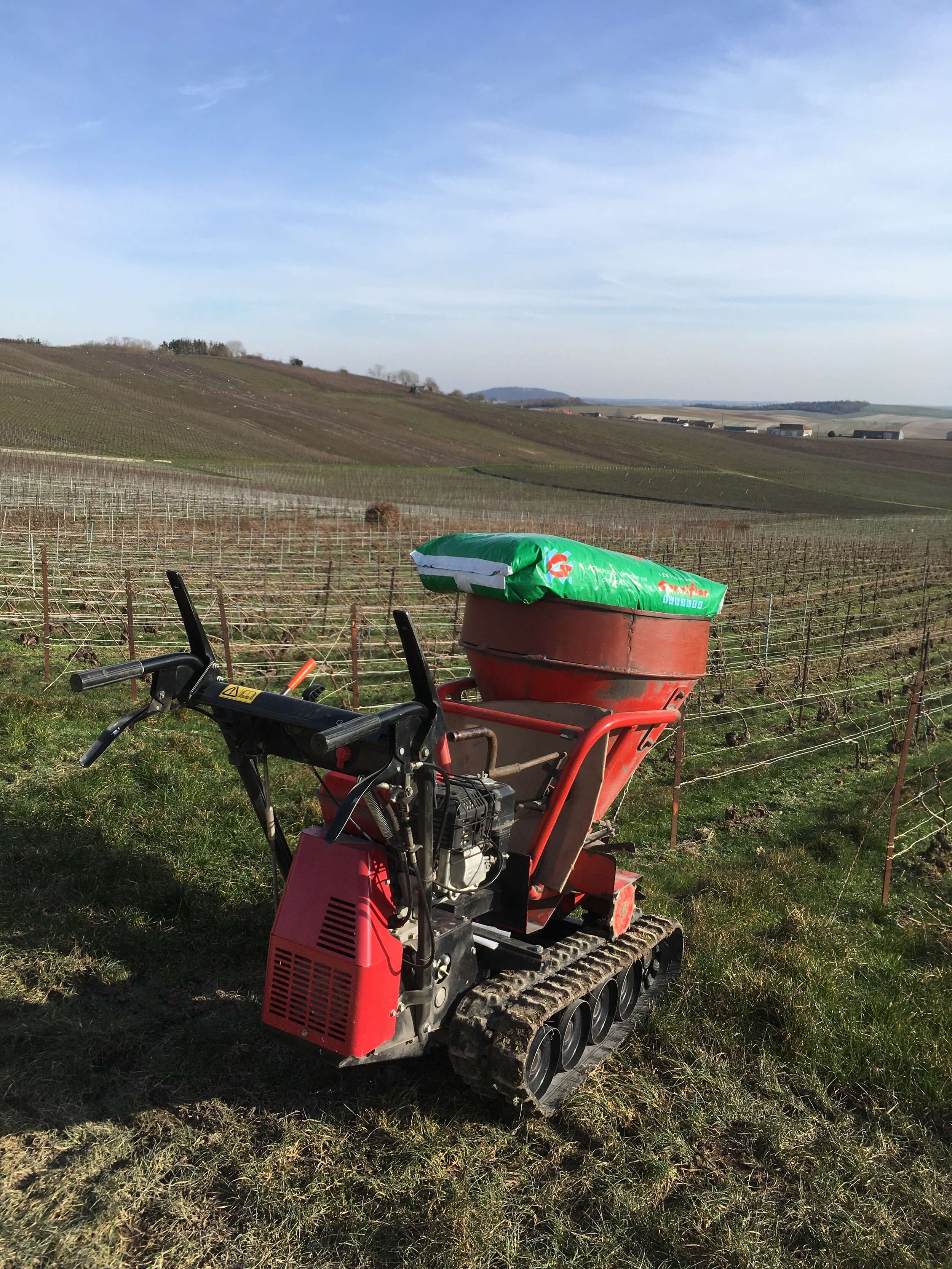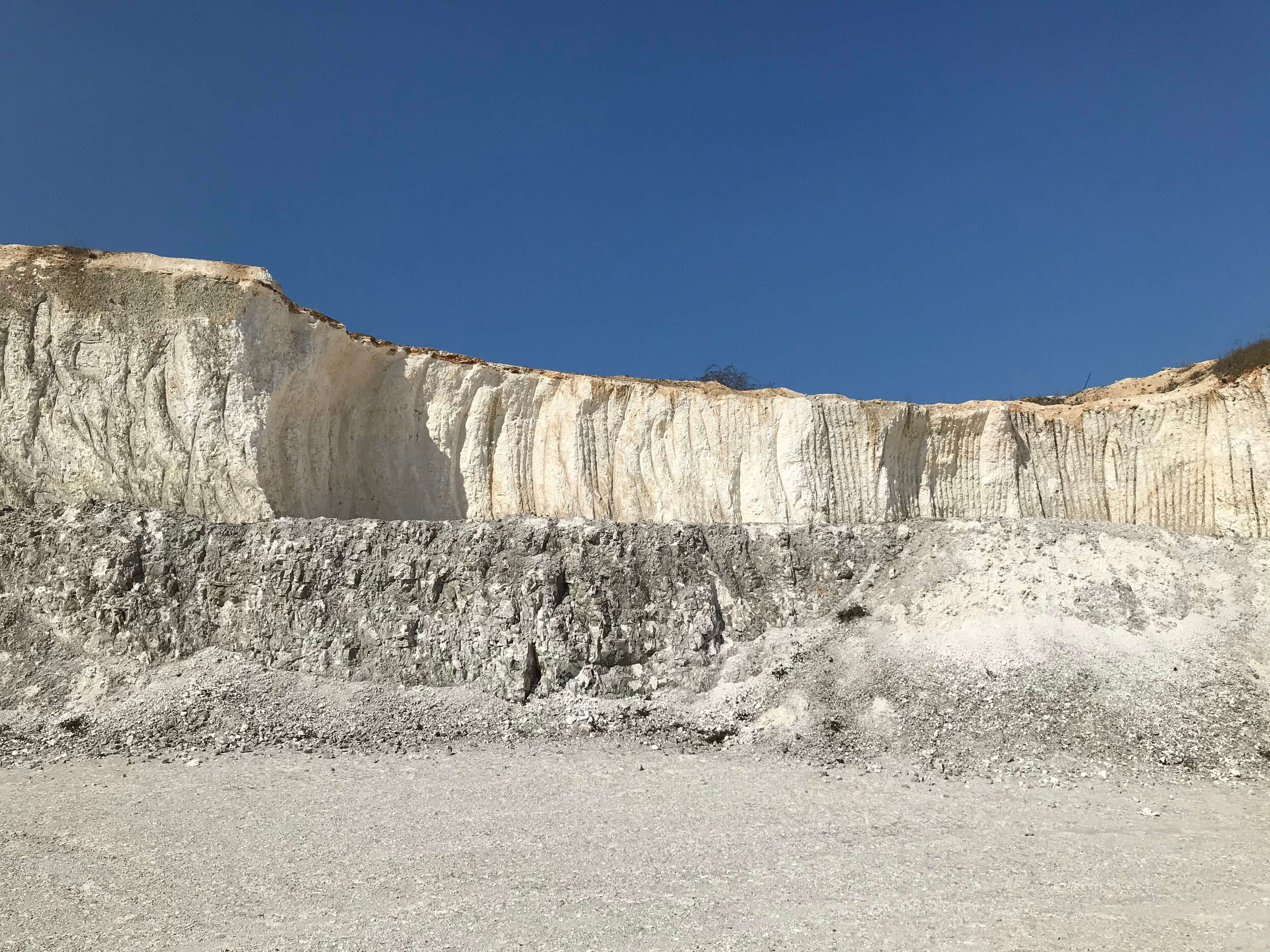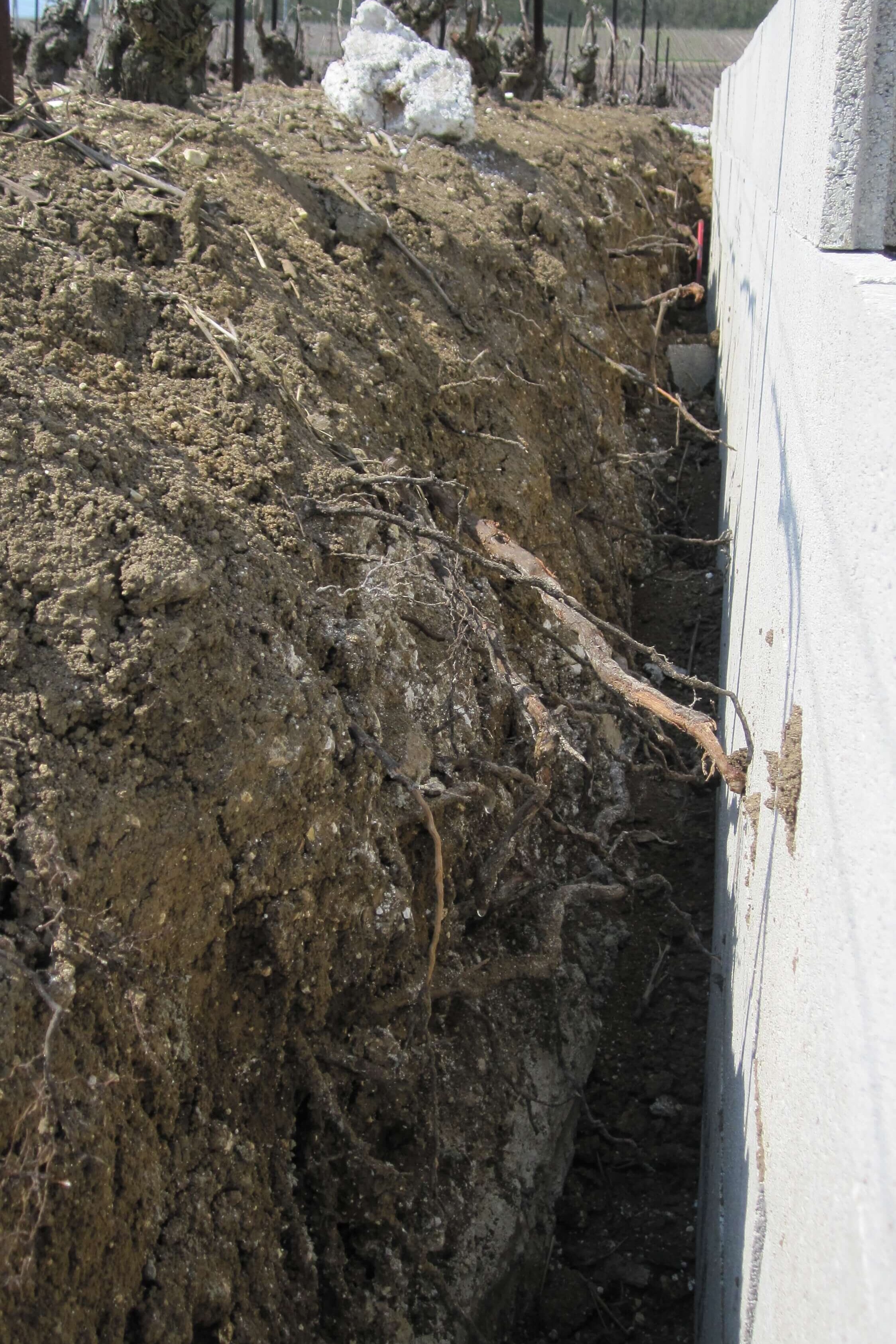Champagne soils: How to feed all plants
These next pages will take you on a journey into and under the white soils of Champagne.
New ways of working in the vineyards have forced our vines to compete with grasses and wild flowers for nutrition.
Stems, leaves and other parts of the plant that are above the ground are nourished by the sun through the photosynthesis (*). But there is also another and hidden part of the meal that takes place underground. And these subterranean supplements are as important for the wellbeing as sunshine.
However, even roots deep underground cannot dig out the essential minerals on their own. Plants in the full range from the tallest of trees to the tiniest of grasses cooperate with other species in the ground for help to complement their meal. A vine in Champagne is no different.
The objective of our work with the soil is to support the underground helpers nourish what is above
Note (*) The photosynthesis: Plants nourish themselves through the photosynthesis. The leaves absorb light, CO2 and water and change these to oxygen and sugar (glucose).
The art of working the soils
A vineyard is not a natural environment. It is planted and controlled by the winegrowers, by us. The vines will find themselves next to other vines with a high density that would never occur in nature.
We regularly take out samples that are analyzed in a lab. But soils change very slowly. Equally important it is to observe the plots. How are the vines doing? Which plants grow naturally? What changes do we notice since last year or last month?
The answers to these questions indicate what happens under the green surface. They are the key to estimate what is otherwise invisible. An important input for our choice of methods.
From conventional to experimental methods
We believe that we have come a long way since this journey began.
The heritage was classic, conventional viticulture in Champagne based on herbicides, insecticides, and pesticides (picture 2). We changed it to something more modern:. Other plants spread naturally between the vines. We work the soils lightly and experiment with green covers and lately biodynamic preparations.
Let’s walk you through these personal experiences on the surface from the last 15 years before we dig further into the ground.
1st experience: grass in the rows
In 2006, we took over half a hectare of Pinot Meunier in a miserable state. We did not know how to proceed. In fact, we expected to replant the plot within some years.
Meanwhile, we began pruning the vines correctly. To prune a vine means to remove most of the branches from the summer in a specific way that will secure some yields and the vigour of the vine. We chose the Cordon-method that works well for the growth of black grapes (picture 4).
“We decided to let plants grow naturally and saw a rich variety of other plants fast.”
Around that time enherbement was about to become compulsory in all vineyards. This means that winegrowers became obliged to either sow something or let plants spread naturally in one third of their vineyards. The edges at ends of plots would be left green as well, instead of bare. This limits the amount of herbicides used. On top of that, the future grasses help fight erosion.
We decided to let plants grow naturally all over this plot. Rather fast, we saw a rich variety of different plants.
Eventually, it did not take many years before the vigour of the vines had improved considerably through correct pruning. We skipped the idea of replanting the entire plot at once. However, the yields remain small in the plot. Maybe because of the competition between the vines and the other plants.
Since 2006, we have let whatever is in the ground grow naturally in all our plots. Now we work continuously on managing the competition everywhere.
2nd experience: ploughing the rows
Next big change came as Alain Gerard got hold of new tools.
A new vineyard tractor is too expensive for a company our size. We waited a while to buy second hand. In 2012, Alain found a veteran enjambeur in a good state equipped with the sought-after tools that would eneable us to stop using herbicides: disks and inter-ceps (*) (picture 1).
When you begin working the soils, you build a lot of experience with time. Our methods haves developped from removal of almost all the grasses into shallow ploughing along the vines and in between them in order to disturb processes underground as little as possible (picture 2).
We usually begin ploughing in March and work it all through twice. Next time is in summer after the flowering of most plants and finally in the autumn to prepare the next season. When the soils are too wet, we cannot work them. Our machine is noisy but not that powerful.
This work is never excactly the same from year to year. The starting point is always our observations of the vineyards. Are they wet? Are they dry? Are there any deficiencies? Or abundances? Are the thistles in flowers? Are the grapes many or few?
When we allow plants to grow naturally in the vineyards, they will compete with the vines. On the other hand, if we remove everything with our tools, new plants will grow instead of those removed. Each plant will suck something underground and we cannot work the soils every week anyway due to lack of time.
Some years, this competition for food can be traced in a lack of growth of some vines.
The solution seems simple. When more dinner guests are seated around the table, the host must bring in more food, n’est-ce pas?
Note (*) Literally translated, inter-ceps means ”between the vines” . It is a tool placed on the specialised tractor that removes plants between the vines. The disks are another tool that works in the row between the lines of vines.
“The cover will grow instead of other plants and help balance the carbon and nitrogen supplies in the plots.”
3rd experience: green covers in the rows
The idea of vegetal covers is common in gardening and in agriculture but has not been much used in viticulture. We decided to try in 2019 and again in 2020.
A vegetal cover is a mix of plants, sown in a line between the vines at the end of the summer. The cover will grow in the autumn and resume in spring but ideally not grow tall before the work of pruning and binding the vines is finished.
The cover will grow instead of other plants. Like this we can have our say regarding what we will find next to the vines. We choose plants that will need water and nutrients in the autumn mainly. At this time, the vines have finished their growth of the year and so competition is avoided.
Typically, a mix will include a cereal, a crucifer, and a leguminous plant that will better the structure of the soil in various ways. The extra carbon brought by these plants stimulate the life of the soils and our combination will balance the nitrogen supplies in the plots better (picture 4).
Cereal: The oat restructures the soil with bundle roots. It binds carbon.
Crucifer: The mustard explores the soil with tap roots. It binds nitrogen.
Leguminous plant: The vetch captures nitrogen from the air and binds it.
The vegetal cover will be put down in spring with the help of new tools. The plants will disintegrate in the vineyards to help maintain the mulch part of the soil. Let’s note that as the plants bind carbon and nitrogen this helps lowering emissions of greenhouse gasses (*).
In the vineyards, this is a major improvement. Before, the natural plants would suck nutrients, then be removed without bringing back anything. The ploughing would leave the soil bare, and new plants would fill the empty space whilst sucking up even more nutrients.
We have gained some experience in this field. The vegetal cover did not appreciate the frost in April, in fact all plants left the plots. And when it comes to the sowing itself, we have discovered, that the period to do it is very short.
The seeds need both water and some warmth to develop. When the summer is too dry, the conditions don’t work. But if the autumn after the grape harvest is cold and wet, the seeds will not grow either. Picture 3 shows how we spread the seeds in a line by shaking a plastic bottle without cap.
We will continue to explore this interesting field though. The objective is to restore the vigour of plants. The conclusion is not yet final though. The frost took it all this year.
Note (*) If plants don’t stock carbon (C) or nitrogen (N) in the ground, these moleculars will connect themselves with oxygen instead, which creates CO2 og N2O, both greenhousegasses.
Widespread spring frost in Champagne, 2021
Early April 2021 is not likely to be forgotten any time soon in Champagne. It qualifies as the most widespread spring frost in the region since 2003.
The morning of April 7th, we found the bottom of the vineyards – and everything else – covered with small pieces of hard snow/ice (picture 1). We had seen it pour down in the late afternoon the day before with no chance to melt. A bit of a horror scenario since frost was announced the following mornings.
Obviously, we expected trouble in the Chardonnays. They were just about to unfold the first leaf. One month later, mid May, the loss remained difficult to evaluate. Some plots were badly frozen, others seemed to grow.
What we don’t know is how the plants managed the frost in a more general way. In the future, we may see some vines weakened or less able to resist disease or sudden temperature shifts. We may observe frailty, but it is not possible to know the exact cause. Possibly, this frost of 2021 made some contribution.
But the experience of frost was an excellent opportunity to acquaint ourselves with biodynamic treatments. In this case, we choose valerian oil to help the vines regain vigour and the preparation 500P (*) to feed the soils.
Note (*) Number 500P is a preparation based on manure from cows, that has been buried in a cow’s horn in the soil for six months. We understand the burial as a process that will help the contents to disintegrate faster for the soil to absorb it faster as well. Furthermore, the 500P contains the elements from the biodynamic compost ( yarrow, camomile, nettle, oak bark, dandelion and valerian).
Latest experience: biodynamic sprays
We completed our first trial of a biodynamic spray on a series of suitable days (*) in April 2021. Obviously after checking up on equipment, timing, weather forecast and procedures, that Alain Gerard had picked up during training on the practical side some years before.
A carefully calculated quantity of collected rainwater was heated on a specific stove (gas) to reach the required 37 degrees Celsius. The preparation 500P was added (picture2) and the dynamisation of the water began. Dynamising the water means to stir in series of specific circular movements for one hour which will mix water and 500P throughly. Finally the preparation was sprayed in the early evening within three hours, not under direct sun and preferably with a bit of moisture (picture 3).
Obviously, a system of ideas like the biodynamic thinking is not learned in one training, after reading one book or trying out a few treatments. We will probably explore more gradually as it fits into the development of our ideas.
Note (*) Suitable day according to the biodynamic Maria Thun calendar which separates days into root, flower, and leaf days. A good day for number 501P is a root day.
Many active forces
This was the fast walk through ways we work in the vineyards. Hopefully you got an idea about the system of plants, soils and climate is in a constant interaction to secure the vines the nourishment they need.
Many active forces are at work in vineyards. Different methods contribute to the whole as described above. We will observe how the vines and the life in the vineyards will develop in 2021 like we do in any year. But we may not name what made the difference.
Likely, it will be a joint venture anyway.
What is above the ground is visible. Down under in the dark, it is more difficult to follow the development.
Let us dig briefly into what soil is for a start.
“Vines and other plants need both the mineral an the organic part of the soil to thrive.”
The bedrock of Champagne
The superficial part of the Earth has two parts. One is mineral and is constituted from the dissolution of the bedrock. The other one is organic, and is made of vegetal and animal parts in dissolution. Vines and other plants need both to thrive.
In Champagne the mineral part is rich on calcium. The region is characterized by chalky bedrock which dates back more than 90 million years when the current hills and valleys were at the bottom of a low sea. The different organisms that lived in these shallow waters are the origins of the different types of chalk in Champagne.
Bring an imaginative tool and dig deep into any parcel: you will reach the hard chalk sometimes close to the surface sometimes many meters underground depending on your location. Picture 3 below shows a chalk mine some 1,5 kilometers from our Soulieres vineyards. Whereas in picture 4, the roots of vines and chalk shows in a depth of about one meter in one of our plots in Loisy-en-Brie. It was visible (barely, below in the picture) due to construction of a wall at the edge of one plot.
This chalk is the reason why irrigation was not an issue for decades and centuries in Champagne. It sucks both water and heat then hand it back. This white massworks like a sponge and may contain up to 40% of its own weight of water. The roots of the vines will find their way down to hydrate themselves from the chalk.
However, the plants need nutrition from the arable land as well.
The constitution of the upper part of the land varies. In the departments of Marne and Aisne, clay or sand is mixed with chalk and in the southern departments of Aube and Haute-Marne the soil is a mix of mainly marl and chalk
The organic part of Champagnes soils
The organic part of the vineyard soils is in constant transformation. The wind and the weather are forces of change. Frost and the thaw that will follow change the structure of the soil. Heatwaves and wind as well dry the soil, consequently it blows away. Heavy rain in the aftermath of storms erode the top soil. Even in plots with a minor inclination. The grasses make a big difference as their roots keep the soil in place.
This soil is where the vines complement their nutrition from the ground via the roots. But plants need the help of certain enzymes to absorb these crucial components. The important enzymes are produced by worms, fungus, and bacteria who live in the root system of the vines (the mycorhize).
In return, the roots of the vines supply glucose and other elements that the enzyme producers would otherwise have to deal with themselves. A perfect symbiosis where each organism specialise and then exchange goods with another specialist to get necessities.
Each time, we plough the soils, we may destroy this fine balance partly. Therefore, we switched to shallow ploughing, that disturbs less.
The choice of fertilizers
Vineyards are grown as a monoculture. Nothing but vines will be cultivated on the land. At the most, the plot may be left without vines for one year at replantation time. A plot is replanted only once every 30 years or less. And on top of this, the vines are planted with a very high density: Little space for many plants.
This means that the soil must be enriched not to be completely impoverished by the lack of crop rotation.
Fertilizers are necessary but neither of any kind nor of any quantity. Vines are hardy plants. Too many fertilizers may help develop many grapes but not necessarily good ones.
The best is manure from cows but few have access to this. Our choice is between synthetic and organic fertilizers. We have used guano for more than 10 years (picture 2), but in strictly measured quantities as the contributions from both the green covers and from grinding the cut off branches after the pruning are part of the quantity needed. The guano pieces are grinded and distributed carefully directly under the vines. All in all a carefully composed meal.
We would like to conclude these paragraphs on the soils and their maintenance with a brief presentation of our own plots.
The soils of our plots
Our plots are situated in three locations in the communes of Soulières and Loisy-en-Brie above Vertus in the Côte des Blancs-region near the Val du Petit Morin. This slope follows a north-south and later an east-west direction in a height of 200 meters above the sea.
The plot of les Crochettes in Soulières spreads on a smooth slope facing east where the chalk is more than one meter away from the surface in its lower part. The topsoil is a mix of sand and chalk. It may get the morning dew of the autumn but is rather sheltered from spring frost (soil sample in picture 1 to the right ). The snowy picture above is from this plot.
The second plot is les Belles Feuilles that covers both sides of a slope between the communes of Soulières and Givry-les-Loisy. The orientation is east-west with a maximum amount of sun from early morning until sunset. The chalk is not far from the surface, which drains the land well (soil sample in picture 1 to the left). The very first picture in the top is from this plot.
The last lieu-dit is les Vieilles Grandmères outside the village of Loisy-en-Brie. We have five plots here. These vineyards are placed on slopes that form an almost perfect semi-bowl facing southeast. The topsoil is clayey in the upper part and the layer of typical chalk a bit deeper. These richer soils allow the vines a stronger growth than in Soulières. They stay wet longer after rain than the plots in Soulières which sometimes complicates the work with the tractor. The second picture in the top is from one of the plots in Loisy-en-Brie.
No final destination
Let’s end this underground adventure above and shortly mention the current status.
From the grapeharvest 2021, we are in conversion to be certified organic in three years. The completed season was incredibly rainy which means that no plants had to fight for access to water. We saw no vines suffer because of lack. Some plots - Chardonnays - did not develop normally because they froze at the worst time possible. As all plots were sprayed with valerian, it’s impossible to know if it made a difference. Eventually, this year of 2021 was more complicated than anything anyone we have exchanged with remember. And still, we did send some pretty good grapes to the presses.
Good grapes are grown when the vines thrive above and underground as a result of the cooperation between the climate and the soil. As these factors are forever changing, we adapt through a mix of approaches and methods that are often not excactly identical between years.
Gradually, we have realized that new challenges often follow as former challenges are solved. There is no final destination. A winegrower who manage his soils can never be bored.
The chef must follow the wish of the clients regarding nutrients and quantities of the soils when he presents his plate. If he wants to stay in business anyway. Bon appetit.
Some sources:
Bodovillé Guillaume : Des couverts dans les galipes (in French)
Agronnomie, Écologie et Innovation TCS No 111, janvier/février 2021Champagne, environnement et développement durable 30 ans d’histoire, le Vigneron Champanois, novembre 2013, Arnaud Descôtes, Dominique Moncomble (in French)
Christian de Carné-Carnavalet: Agriculture biologique, Editions France Agricole, 2011 (in French)
Cukierman Jérémy, Quénol Hervé, Michelle Bouffard: Quel vin pour demain, Dunod 2021 (in French)
Diverse numre af le Vigneron Champenois og La Champagne Viticole, to månedlige udgivelser fra Comité Champagne og Foreningen af Vinbonder i Champagne (in French)
Maison des Champagnes: Om Champagne-regionen (in French)
Wikipedia: Oversigt over geologiske tidsaldre (in French)
EPA: Oversigt over drivhusgasser (in English)



